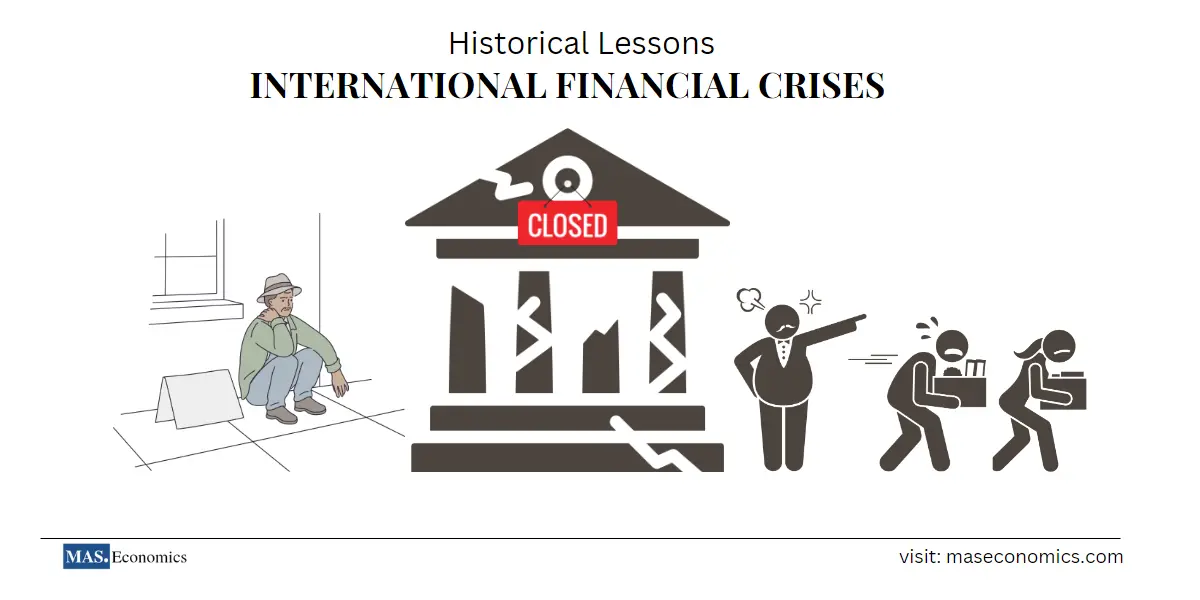Financial crises have been happening for centuries, and it can be helpful to look at their history to understand better where we stand today. To get an overall perspective, we can look at the most significant financial crises of all time, starting with the South Sea Bubble in 1720.
The South Sea Bubble of 1720
The South Sea Bubble was a significant stock market crash that took place in England during the early 1700s. It began when a company called the South Sea Company made a deal with the government of England to take on the national debt in exchange for exclusive rights to trade in certain regions. The company’s stocks rose dramatically as investors speculated on its potential profits, but eventually, there was no actual return on their investments, and many lost large sums of money. This event has since been seen as an early example of mass mania leading to a financial crisis.
The Great Depression of 1929
In the 1870s, global financial integration ended when World War I began in 1914, and efforts to bring stability to the international monetary and financial system were unsuccessful. During the 1920s and 1930s, finances and the economy faced instability worldwide.
The next major crisis was the Great Depression of 1929, caused by stock market crashes and a reluctance by banks to lend money due to fears of nonpayment. As consumer investments declined drastically and businesses declared bankruptcy, unemployment rates increased significantly across the globe.
In 1933, President Franklin D Roosevelt launched a pioneering stimulus program in an effort to reduce unemployment figures and restore economic balance over time.
The exact cause of the Great Depression is still disputed among economists, but many agree that it was due to a combination of factors. One of these was the collapse in U.S. stock prices starting in October 1929—the American economy had relied mainly on stock market speculation for growth. So when investors suddenly panicked and sold off their holdings en masse, it caused prices to plummet dramatically, leading many investors to lose large amounts of money overnight. Additionally, banks were lending out huge sums at low-interest rates, which led to over-investment. At the same time, taxes were already low, meaning there was insufficient government revenue to service its debt obligations or pay for relief programs during this crisis.
In response, most governments adopted austerity measures such as reducing public spending or raising taxes which further hampered domestic output by negatively affecting consumer confidence even more. This spiral continued until 1933, when President Roosevelt implemented his New Deal policies which began changing the direction of America’s recovery path through federal intervention, such as providing public spending for infrastructure projects and welfare benefits for those who needed them most.
The Great Depression devastated and affected the U.S. economy: GDP dropped by 29%, unemployment hit 25%, consumer prices decreased by 25%, and wholesale prices experienced an even steeper decline of 32%. Additionally, around 7,000 banks, almost one-third of the banking system, failed in those years.
This meant poverty becoming increasingly common as citizens struggled to make ends meet. At the same time, entire nations saw their GDPs significantly lowered in terms of what could have been achieved pre-depression period. The Great Depression has since served as a constant reminder about how fragile economic theory can be when not appropriately managed. Leading governments worldwide to take extra cautionary steps towards preventing large-scale recessions from occurring too often or too severely, if possible!
The International Debt Crisis 1980s
Following World War II, international capital flows were limited due to government regulations. However, in the 1970s, increased commodity prices and low real interest rates resulted in many developing countries acquiring large loans from banks interested in recycling petrodollars from oil-exporting countries. Unfortunately, much of this loan was used to fund government expenditures rather than productive investments.
In the early 1980s, a global economic slump caused commodity prices to drop and interest rates to rise, resulting in many developing countries being unable to meet their financial obligations. A long and challenging debt crisis ensued, with governments of these countries having to make significant adjustments to their current accounts and reschedule debts. These measures led to a dramatic decrease in private financial flows over the decade.
The International Debt Crisis is an ongoing economic issue that has caused immense harm and suffering worldwide. It dates back to the early 1980s when banks and international financial institutions issued a wave of loans and debt investments to developing countries with little-to-no oversight. These funds, intended to finance the governments of these nations, often came with high-interest rates that made repayment difficult or impossible in many cases.
As repayment became more and more difficult for some of these countries, needy populations suffered due to government austerity measures imposed on them as part of their debt restructuring agreements. This included cuts to social spending for essential services such as health, education, and even food subsidies, further perpetuating poverty caused by this crisis. Additionally, foreign aid, which could have been used to alleviate some of this suffering, was curtailed, meaning that many people had no other recourse than relying on whatever meager resource transfer they could receive from relatives abroad.
The crisis has since been somewhat alleviated due to initiatives such as the Heavily Indebted Poor Countries Initiative (HIPC). This program provided low-income countries with a significant reduction in their external debt burden by allowing them access to debt relief through concerted international efforts involving private creditors and public financial institutions like the World Bank and IMF. Going forward, all parties involved in these negotiations must consider the need for sustainable development while also recognizing/caring about how heavily indebted countries are feeling post-restructuring. Only then can economic progress indeed be achieved efficiently throughout all nations concerned.
After the debt crisis of the 1980s had been resolved, capital investment returned to emerging markets in more significant numbers, with a larger share of investments taking form in equity and bonds. Unfortunately, this was followed by a new round of financial crises, starting with Mexico in 1994 and leading up to Russia and Brazil in 1998, raising questions about the safety of having an interconnected global financial system.
The Asian Economic Crisis of 1997
The Asian Economic Crisis of 1997 was an economic downturn that gripped much of East and Southeast Asia in the mid-1990s. It began when a series of currency devaluations caused by overvalued exchange rates, speculative investment, and subsequent capital outflows led to drastic drops in asset prices and demand for many goods, services, and investments across the region.
The crisis originated from a lack of governmental oversight in many countries regarding macroeconomic management and poor fiscal policies. Thailand had placed too much emphasis on exports, and its currency was overvalued. In contrast, Indonesia had high levels of government debt. Their banking sector struggled to cope with the increased foreign borrowing that it had taken on—both resulted in large current account deficits, which made these countries vulnerable to external shocks. Such as investments being pulled out by international investors who no longer saw any returns or stability in the region’s markets.
In 1996 and 1997, economic growth in Indonesia, Thailand, Malaysia, South Korea, and the Philippines experienced sharp drops in nominal GDP per capita. Although Hong Kong, Mainland China, Singapore, and Japan were also affected to some degree, their declines were less severe.
The result was catastrophic in Thailand, Malaysia, South Korea, and the Philippines experienced sharp drops in nominal GDP per capita. Although Hong Kong, Mainland China, Singapore, and Japan were also affected to some degree, their declines were less severe. Millions of people fall into poverty, unemployment reaches a high shock rate, and entire industries, such as manufacturing, are wiped out overnight. The ripple effect can still be felt today as deflationary pressures lingered long after the initial crash leading some economies like Thailand to experience years more suffering than others due to this unfortunate event.
The Asian financial crisis serves as an important reminder that failure to properly manage the vulnerability of one country can lead to a destabilization of an entire region. To discourage future occurrences, governments have increased their focus on regulating capital flows and improving macroeconomic policies to solidify sustainable growth rather than continuing reliance on external strategies such as the export industry. Implementing these adjustments will prevent a repeat of the events in 1997.
After Argentina’s default on its external debt in 2001, the early 2000s saw relative stability in international financial markets. This ended with the “subprime” crisis in the U.S. of 2007–2008, which marked the start of the first global financial crisis of the 21st century – aptly named the “Great Recession.”
The Great Recession: Global Financial Crisis of 2008
In 2008, the United States experienced one of its most severe financial disasters – the Great Recession, or Global Financial Crisis (GFC). The crisis began with banks giving out risky subprime mortgage loans without proper oversight. This issue quickly spread to other Wall Street firms investing heavily in these unregulated products. When housing prices crashed, and borrowers could not make their payments, it created a domino effect of mass layoffs and job losses across the globe, leaving entire populations with abnormally high levels of household debt.
To understand why this recession occurred, it is vital to consider what happened before it. In the mid-2000s, housing prices grew rapidly as investors anticipated making profits from buying and reselling mortgages provided by unreliable creditors. When the bubble popped, some borrowers could not keep up with their payments or lost their houses due to the depreciated value of their investments. This ‘toxic’ debt was then transferred among firms that had unknowingly acquired them from other sources, resulting in an extensive financial crisis that spread throughout Europe.
The effects of the recession were devastating — in America alone, 8 million jobs were gone, and unemployment rates skyrocketed. Furthermore, as the economies of other nations relied on American output, demand dried up globally, and productivity and aggregate income decreased sharply. Investment banking operations were hit hard, prompting governments to intervene with bailouts and quantitative easing programs in an effort to restore stability.
To prevent similar events from occurring in the future, it is paramount to ensure a healthy balance between risk and safety in lending practices and to impose stricter regulations around Wall Street speculation. All parties must have better accountability so we can learn from this crisis, making sure our economy remains strong going forward.
Covid-19 Pandemic Lesson from previous Financial Crises
More recently, in 2020, countries worldwide have had to face another crisis brought about by COVID-19—different from previous ones due to its global health implications rather than merely economic ones. Like before, amidst all local efforts to help minimize contagion rates, there are still numerous monetary concerns, such as increased levels of public debt and skyrocketing unemployment numbers for individuals and small businesses.
The Covid-19 pandemic has shown the importance of financial stability and preparation in light of previous global financial crises. Governments and organizations have understood the need for regulated practices to protect people from economic struggle. Consequently, more focus is being put on teaching people how to manage their finances independently of world events through financial literacy and resilience measures.
By examining past financial crises, we can recognize specific patterns and essential tips for countries to learn from in order to be better prepared for similar events in the future. This includes forming strong fiscal policies instead of relying on quick fixes or listening only to specific groups. Learning from history is a great way to protect our economies from unnecessary damage, regardless of what happens.
Conclusion
Historical financial crises have taught us valuable lessons, from the Great Depression to the Global Financial Crisis and now to COVID- 19. These events have revealed common issues such as rapid debt accumulation, ineffective economic and financial regulations, excessive risk-taking, and globalization. Our financial system is interconnected and delicate; increasing international cooperation alongside improved regulation and risk management can lead to a more resilient global economy.




